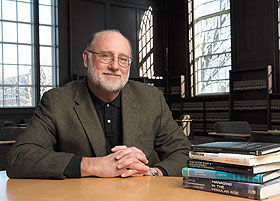  |
| HOME | THIS ISSUE | CALENDAR | GRANTS | BACK ISSUES | < BACK | NEXT > |
Economist contrasts old and new corporate structures
| ||||
| Corporations lend themselves to all sorts of labels, depending on one’s point of view. They can be innovative or exploitative; creative or conniving, and perhaps for MSNBC watchers, they’re just symbols scrolling across the bottom of a television screen, ripe for investment. But for Richard Langlois, an award-winning UConn economics professor, corporations are like Lego toys, structures that can be configured in any number of ways. He often sees them as “vertical” or “horizontal,” simple labels that make a convenient jumping-off point for the kind of discussion economists have been having for at least 100 years. Much of his research focuses on the work of the prominent economist Joseph Schumpeter, who died in 1950, and a business historian named Alfred Chandler Jr., who taught at Harvard and died earlier this year. Langlois’s 2004 book, Dynamics of Industrial Capitalism, received the 2006 Schumpeter Prize of the International Joseph A. Schumpeter Society. In the book and in other research, Langlois looks at the views of Schumpeter and Chandler and assesses how well they have stood the test of time. Often, he finds bends in the economic road that they could not have foreseen. “Chandler was writing in the middle of the 20th century, when protectionism was common and markets were more closed,” Langlois says. “He saw the rise of the large, vertically integrated company as the inevitable product of economic development. His argument would be less persuasive today.” Economists call a company vertically integrated if it tends to handle most stages of production by itself. An example, Langlois says, is the IBM of yesterday. “IBM used to make its own transistors, its own motherboards,” he says. “It owned divisions that made almost every part of the computer, and the company was structured like a silo.” No longer. “Today, corporations are mostly horizontal, with production spread out among many companies and entrepreneurs everywhere,” he says. “That’s the idea of the new economy.” Langlois is interested in how corporations evolve, and why. In the case of IBM, he says, the company started keeping all the components of a computer under its corporate roof, but before long had to yield to specialist companies that were moving different computer technologies forward faster and more economically than the large corporation could. A similar situation evolved with the oil companies, Langlois says. They used to handle all aspects of production, from exploration to refining to distribution and sale to consumers, or, as Langlois puts it, “They did it all, everything but making the steel that went into the drills, or the typewriters in their offices. Langlois argues that it’s wrong to see a large vertically integrated corporation as “the apotheosis of organizational form.” Instead, he sees it as the second-best form, “the form you would get when markets can’t catch up to supply what is needed for success,” he says. “If you specialize in only doing a few things,” he adds, “that’s better than trying to do everything, particularly in view of the possibilities created by globalization.”
In an article written in 1992 for the Harvard Business History Review, Langlois takes a detailed look at the early days of the computer industry. Though dated now, the article is filled with insights about why so many of the early names – among them Digital Equipment Corp. (DEC), Leading Edge, Atari, and Wang – are distant memories today. In the article, he also discusses another favorite theme, modular systems, and the benefits they have brought to consumers and businesses alike. In describing the computer industry as it had evolved to that point, Langlois concludes that Chandler’s view that strong, vertically integrated companies are the best engines of economic growth could not apply to the computer industry. DEC’s missteps were many, Langlois says. On the question of how to structure the business, he wrote: “… DEC chose to ignore existing third-party capabilities. Except for the hard disk and the line cord, DEC designed and built every piece of the Professional. The company tooled the sheet metal and the plastics, manufactured the floppy drive, and even developed the microprocessor.” Successful companies like Compaq, Langlois noted, realized right away that they should not produce all components in-house. He tells the story of a Compaq senior manager sending several executives to a computer trade show. “They discovered that the company could buy parts in the market and assemble a PC for far less than Compaq’s own internal production costs,” Langlois wrote. The computer industry, he added, “is largely a story of external economies … of the development of capabilities within the context of a decentralized market, rather than within large vertically integrated firms.” Langlois said the industry contrasted diametrically with Chandler’s vision of one company effectively buying its way into a dominant position in an industry, putting in place along the way such keys to success as excellent management, marketing, and production. Henry Ford, Langlois wrote, had to integrate vertically “because external markets could not create capabilities as fast as he could.” But decades later, IBM went outside its own walls “because the company could not create capabilities as fast as the market could.” Ironically, Ford pioneered mass production, the very force behind so many of the successful computer component enterprises. Before focusing on the engineering of economic systems, Langlois earned degrees in physics, English literature, and astrophysics. He has received many awards at UConn, including the Provost’s Research Excellence Award in 2006, and the Alumni Association Faculty Excellence in Research Award in 2007. |
| ADVANCE HOME UCONN HOME |

